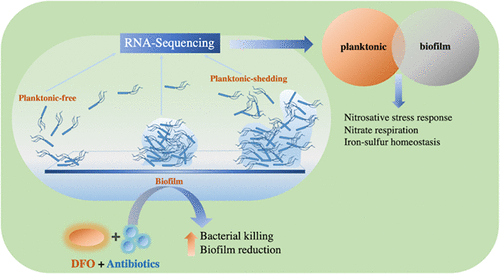当前位置:
X-MOL 学术
›
ACS Infect. Dis.
›
论文详情
Our official English website, www.x-mol.net, welcomes your feedback! (Note: you will need to create a separate account there.)
Transcriptomics Analysis Uncovers Transient Ceftazidime Tolerance in Burkholderia Biofilms
ACS Infectious Diseases ( IF 5.3 ) Pub Date : 2021-06-17 , DOI: 10.1021/acsinfecdis.1c00003 Supaksorn Chattagul 1, 2 , Mohd M Khan 3, 4 , Alison J Scott 5 , Aleksandra Nita-Lazar 4 , Robert K Ernst 5 , David R Goodlett 5 , Rasana W Sermswan 1, 2
ACS Infectious Diseases ( IF 5.3 ) Pub Date : 2021-06-17 , DOI: 10.1021/acsinfecdis.1c00003 Supaksorn Chattagul 1, 2 , Mohd M Khan 3, 4 , Alison J Scott 5 , Aleksandra Nita-Lazar 4 , Robert K Ernst 5 , David R Goodlett 5 , Rasana W Sermswan 1, 2
Affiliation

|
Burkholderia pseudomallei is an etiological agent of melioidosis, a severe community-acquired infectious disease. B. pseudomallei strain K96243 is sensitive to the drug ceftazidime (CAZ), but has been shown to exhibit transient CAZ tolerance when in a biofilm form. To investigate an observed shift in gene expression profile during CAZ tolerance condition and to better understand the mechanistic aspects of this transient tolerance, RNA-sequencing was performed on B. pseudomallei K96243 from the following three states: planktonic, biofilm, and planktonic shedding. Results indicated that the expression of 651 genes (10.97%) were significantly changed in both biofilm (resistant) and planktonic shedding (sensitive) cells in comparison to the planktonic state. The top four highly expressed genes identified in both states are associated with nitrosative stress response (BPSL2368), Fe–S homeostasis (BPSL2369), and nitrate respiration (BPSS1154 and BPSS1158). Additionally, five orthologous genes, BPSL2370–BPSL2374, implicated in Fe–S cluster biogenesis, and another gene, BPSL2863, involved in DNA-binding of the stress protein ferritin, were shown to increase expression by RT-qPCR. The shift in gene expression was especially prominent at the late stages of biofilm growth (72 and 96 h), specifically in the biofilm-challenged CAZ survivor cells. This suggested that in response to stress in a biofilm, differential expression of these genes may support development of the CAZ tolerance in Burkholderia. The application of iron chelator deferoxamine (DFO) to the biofilm caused a significant reduction in biofilm formation and associated CAZ tolerance. Therefore, the shift in Fe–S metabolism when B. pseudomallei is in a biofilm may help stabilize the levels of reactive oxygen species (ROS), thereby limiting tolerance to CAZ.
中文翻译:

转录组学分析揭示伯克霍尔德菌生物膜中的瞬时头孢他啶耐受性
Burkholderia pseudomallei是类鼻疽病的病原体,这是一种严重的社区获得性传染病。B. pseudomallei菌株 K96243 对药物头孢他啶 (CAZ) 敏感,但已显示在生物膜形式时表现出短暂的 CAZ 耐受性。为了研究在 CAZ 耐受条件下观察到的基因表达谱的变化并更好地理解这种瞬时耐受的机制方面,对B. pseudomallei进行了 RNA 测序K96243 来自以下三种状态:浮游、生物膜和浮游脱落。结果表明,与浮游状态相比,生物膜(抗性)和浮游脱落(敏感)细胞中 651 个基因(10.97%)的表达发生了显着变化。在这两个州中鉴定出的前四个高表达基因与亚硝化应激反应 (BPSL2368)、Fe-S 稳态 (BPSL2369) 和硝酸盐呼吸 (BPSS1154 和 BPSS1158) 相关。此外,5 个直系同源基因 BPSL2370–BPSL2374 与 Fe-S 簇的生物发生有关,另一个基因 BPSL2863 参与应激蛋白铁蛋白的 DNA 结合,通过 RT-qPCR 显示增加了表达。基因表达的转变在生物膜生长的后期(72 和 96 小时)尤为突出,特别是在生物膜挑战的 CAZ 幸存细胞中。这表明,为了应对生物膜中的压力,这些基因的差异表达可能支持 CAZ 耐受性的发展。伯克霍尔德氏菌。将铁螯合剂去铁胺 (DFO) 应用于生物膜导致生物膜形成和相关的 CAZ 耐受性显着降低。因此,当B. pseudomallei在生物膜中时,Fe-S 代谢的变化可能有助于稳定活性氧 (ROS) 的水平,从而限制对 CAZ 的耐受性。
更新日期:2021-08-13
中文翻译:

转录组学分析揭示伯克霍尔德菌生物膜中的瞬时头孢他啶耐受性
Burkholderia pseudomallei是类鼻疽病的病原体,这是一种严重的社区获得性传染病。B. pseudomallei菌株 K96243 对药物头孢他啶 (CAZ) 敏感,但已显示在生物膜形式时表现出短暂的 CAZ 耐受性。为了研究在 CAZ 耐受条件下观察到的基因表达谱的变化并更好地理解这种瞬时耐受的机制方面,对B. pseudomallei进行了 RNA 测序K96243 来自以下三种状态:浮游、生物膜和浮游脱落。结果表明,与浮游状态相比,生物膜(抗性)和浮游脱落(敏感)细胞中 651 个基因(10.97%)的表达发生了显着变化。在这两个州中鉴定出的前四个高表达基因与亚硝化应激反应 (BPSL2368)、Fe-S 稳态 (BPSL2369) 和硝酸盐呼吸 (BPSS1154 和 BPSS1158) 相关。此外,5 个直系同源基因 BPSL2370–BPSL2374 与 Fe-S 簇的生物发生有关,另一个基因 BPSL2863 参与应激蛋白铁蛋白的 DNA 结合,通过 RT-qPCR 显示增加了表达。基因表达的转变在生物膜生长的后期(72 和 96 小时)尤为突出,特别是在生物膜挑战的 CAZ 幸存细胞中。这表明,为了应对生物膜中的压力,这些基因的差异表达可能支持 CAZ 耐受性的发展。伯克霍尔德氏菌。将铁螯合剂去铁胺 (DFO) 应用于生物膜导致生物膜形成和相关的 CAZ 耐受性显着降低。因此,当B. pseudomallei在生物膜中时,Fe-S 代谢的变化可能有助于稳定活性氧 (ROS) 的水平,从而限制对 CAZ 的耐受性。



























 京公网安备 11010802027423号
京公网安备 11010802027423号